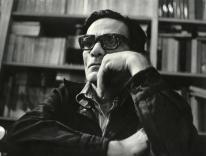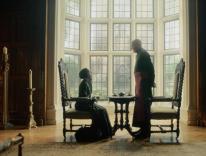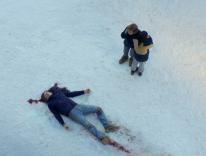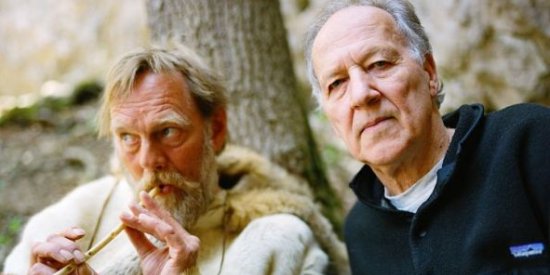
In 1994 three spelunkers in the south of France stumbled upon a huge find. Exploring a fissure in a limestone formation, they discovered a cave whose chambers contained dozens of wall paintings—paintings perfectly preserved, subsequent carbon dating revealed, for thirty millennia. The Chauvet cave’s dreamlike depictions of horses, rhinos, woolly mammoths, and other prehistoric creatures constitute the oldest known examples of human pictorial art, and, as such, open a window on the prehistoric imagination. Perhaps most alluring is a recurring handprint, pressed on the rock in red paint and showing a slightly crooked little finger: the signature of the prehistoric artist. Fearful that opening the site to tourism would degrade the paintings, the French government put up a steel door to bar everyone but a few researchers. Last year, however, the German director Werner Herzog was allowed to take a small film crew inside. His footage, plus interviews with various experts, make up Cave of Forgotten Dreams.
Herzog would seem the perfect man for such a project. In half a century of films, he has repeatedly explored the atavistic, the grandiose, the magical, and the strange. Abjuring any interest whatsoever in contemporary life, he has taken up Mayan creation myths, bloodthirsty conquistadores questing for El Dorado, vampires, aboriginal peoples, sages and seers, and outcasts. His dozen full-length documentaries have favored jungle, arctic, or desert settings. Herzog’s is a cinema of the extreme, dedicated to excavating deep beneath the humdrum routine that civilization lays down atop our primitive, passionate, soulful selves.
Cave of Dreams is full of mesmerizing beauty. Not least are the weird crystal formations in the cave, a kind of surreal natural sculpture. The paintings themselves seem at once ancient and surprisingly modern—animal studies done in a smooth and assured line, replete with ample naturalistic detail, depth, and also, it seems, affection, suggesting a primordial outlook rooted as much in wonder and praise as in wariness and fear. Several are executed in a kind of multiple-image technique, as if to suggest motion. (“They are a form of proto-cinema,” Herzog comments, dubiously.) It is impossible to see them and not be moved by the messages sent to us directly across the whole of human history by whoever owned that crooked-fingered hand.
Yet Cave of Dreams says less about humanity, or the owner of that hand, than it does about Herzog and his insistent need to uncover a primordial sense of the sacred. One realizes that this cave ratifies an essential idea in his Weltanschauung—that if we can only scoop away the entirety of civilization and reconnect with something primitive, we will rediscover the unspoiled and the authentic, both in the world and within ourselves. There is something distinctly prelapsarian in the vision that takes shape under the light of Herzog’s awe. His religion is not at all Christian, but pagan. It does not deal in sin, merely celebration and ecstasy.
Herzog is hard-pressed to convey this ecstasy—though he certainly tries. Way too hard, in fact. I have always enjoyed his documentary voice-overs, his obscurely accented voice (Bavarian with British highlights) conveying a deadpan philosophical seriousness touched with drollery. There’s no one better at waxing apocalyptic. Herzog’s 2005 documentary Grizzly Man chronicled an eccentric American named Tim Treadwell who spent years living with bears in remote Alaska, and was eventually mauled to death for his efforts. “Treadwell saw nature as benign and harmonious,” intoned the director with grim matter-of-factness, “whereas I believe the common character of the universe is not harmony, but hostility, chaos, and murder.” Jawohl!
Cave of Dreams shows conclusively that Herzog is better at dark grandiosity than the worshipful sublime. Determined that we share his awe, he subjects us to a drumbeat of relentless rhapsody. His musings combine the unanswerable (“What does it mean to be human?”) with the indecipherable (“The cave is like a frozen flash of a moment in time”). I’ve never considered Herzog facile before, or insincere, but when he informs us that “it’s as if the human soul had awakened here,” I find myself resisting. He resorts to gimmicks, at one point commanding his crew to be quiet. “We can listen to the silence in the cave,” Herzog tells us, “and perhaps we can even hear our own heartbeats.” And sure enough, as if through a doctor’s stethoscope, here it comes...duh-dum, duh-dum, duh-dum.... At such moments Herzog risks becoming a cutesy tour guide.
Cave of Dreams offers relief from the auteur’s droning portentousness in the occasional oddball he interviews—a researcher who dresses up in bearskins to show us prehistoric fashion, or a master perfumer who searches for caves by sniffing along the sites of likely openings. However entertaining, though, these diversions feel like padding; and in the end, I’m not sure there was enough material here for an entire film. A half-hour silent survey of the paintings might have sufficed. Herzog should have shut up and let the visions speak for themselves.
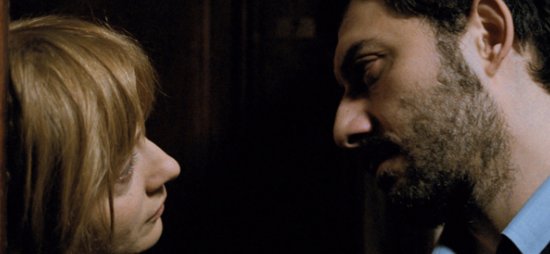
“Did they dream?” Herzog wonders aloud about the prehistoric residents of the Chauvet cave. The Italian mystery The Double Hour addresses that question with inventive brio. La doppia ora—the title reflects an ironic take on the belief that whenever a clock shows the same number twice (e.g., 11:11), you should make a wish—is the debut effort of Giuseppe Capotondi, whose previous work has been in music videos and commercials. It is a skillful piece of storytelling, taking us again and again to the alluring, disturbing place where a dream teeters between bliss and nightmare.
Set in Turin, the movie follows Sonia (Ksenia Rappoport), a Slovenian immigrant working as a hotel chambermaid, and Guido (Filippo Timi), an ex-cop employed as a security guard at a wealthy country estate. The two meet at a dreary speed-dating event, fall hard for one another, and begin a romance. But when Guido invites Sonia to the estate, then briefly abandons his control room with its surveillance cameras to take her for a romantic walk in the woods, they’re set upon by a team of highly professional thieves who bind them and proceed to strip the mansion of paintings, silver, furniture, and everything else of value. When one of the masked bandits begins to molest Sonia, Guido—hands still bound behind his back—manages to attack him with a violent head butt. Soon a gun goes off, and the movie plunges into chaos and tragedy.
I can’t describe what happens next without spoiling things. Suffice it to say that the film’s turns appear to conflate dream and reality, leaving us for long stretches in doubt about what we’re seeing. There’s nothing in this setup that fans of thrillers like Vertigo and The Sixth Sense haven’t seen before. Yet the film is surprisingly satisfying. Capotondi meets the demands of the genre perfectly, then surmounts them, turning his film into a study of guilt and—strange thing to say—the power of love. Cinematically, this means smuggling a romance into the heart of a neo-noir crime thriller, where you least expect it.
The Double Hour is precisely the kind of film whose success depends on the things Werner Herzog has no use for—the calculus of everyday desires and deceptions, the significance of the smallest gesture or overheard snatch of conversation. This kind of film displays perfect timing and the adroit manipulation of tone. Polish, rather than profundity, is its watchword. And excellent acting. Roguishly handsome, Timi looks like an Italian Javier Bardem, while Rappoport’s versatile beauty proves in turns ethereal and erotic. This versatility is crucial to the film’s unwinding. At the outset Sonia appears dazed and depressed, a vulnerable foreigner ripe for victimization; yet as The Double Hour progresses, we begin to wonder whether her downtrodden neediness might be merely a guise. Was the seemingly accidental meeting at the speed-dating event in fact no accident at all? Answering this question has Capotondi channeling Hitchcock, with more than a touch of Roman Polanski, drenching innocuous images in dread, slowing down the camerawork to capture recurring motifs and bring them to the point of the obsessive.
Films such as The Double Hour are meant to unsettle us, to make us less at home in the world by giving us structures of reference and assurance—familiarity, really—and then wiping them out. Just the opposite, perhaps, of what prehistoric man, that proto-cinematographer, was doing when he tossed up images on the rock wall.
Please email comments to [email protected] and join the conversation on our Facebook page.
Share
Previous Story
Canary in the Coalmine
Next Story
The Cold War on Ice
